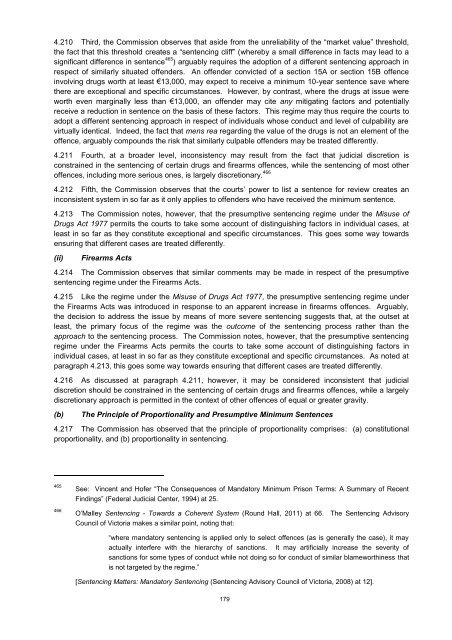Report on Mandatory Sentences - Law Reform Commission
Report on Mandatory Sentences - Law Reform Commission
Report on Mandatory Sentences - Law Reform Commission
You also want an ePaper? Increase the reach of your titles
YUMPU automatically turns print PDFs into web optimized ePapers that Google loves.
4.210 Third, the Commissi<strong>on</strong> observes that aside from the unreliability of the “market value” threshold,<br />
the fact that this threshold creates a “sentencing cliff” (whereby a small difference in facts may lead to a<br />
significant difference in sentence 465 ) arguably requires the adopti<strong>on</strong> of a different sentencing approach in<br />
respect of similarly situated offenders. An offender c<strong>on</strong>victed of a secti<strong>on</strong> 15A or secti<strong>on</strong> 15B offence<br />
involving drugs worth at least €13,000, may expect to receive a minimum 10-year sentence save where<br />
there are excepti<strong>on</strong>al and specific circumstances. However, by c<strong>on</strong>trast, where the drugs at issue were<br />
worth even marginally less than €13,000, an offender may cite any mitigating factors and potentially<br />
receive a reducti<strong>on</strong> in sentence <strong>on</strong> the basis of these factors. This regime may thus require the courts to<br />
adopt a different sentencing approach in respect of individuals whose c<strong>on</strong>duct and level of culpability are<br />
virtually identical. Indeed, the fact that mens rea regarding the value of the drugs is not an element of the<br />
offence, arguably compounds the risk that similarly culpable offenders may be treated differently.<br />
4.211 Fourth, at a broader level, inc<strong>on</strong>sistency may result from the fact that judicial discreti<strong>on</strong> is<br />
c<strong>on</strong>strained in the sentencing of certain drugs and firearms offences, while the sentencing of most other<br />
offences, including more serious <strong>on</strong>es, is largely discreti<strong>on</strong>ary. 466<br />
4.212 Fifth, the Commissi<strong>on</strong> observes that the courts’ power to list a sentence for review creates an<br />
inc<strong>on</strong>sistent system in so far as it <strong>on</strong>ly applies to offenders who have received the minimum sentence.<br />
4.213 The Commissi<strong>on</strong> notes, however, that the presumptive sentencing regime under the Misuse of<br />
Drugs Act 1977 permits the courts to take some account of distinguishing factors in individual cases, at<br />
least in so far as they c<strong>on</strong>stitute excepti<strong>on</strong>al and specific circumstances. This goes some way towards<br />
ensuring that different cases are treated differently.<br />
(ii)<br />
Firearms Acts<br />
4.214 The Commissi<strong>on</strong> observes that similar comments may be made in respect of the presumptive<br />
sentencing regime under the Firearms Acts.<br />
4.215 Like the regime under the Misuse of Drugs Act 1977, the presumptive sentencing regime under<br />
the Firearms Acts was introduced in resp<strong>on</strong>se to an apparent increase in firearms offences. Arguably,<br />
the decisi<strong>on</strong> to address the issue by means of more severe sentencing suggests that, at the outset at<br />
least, the primary focus of the regime was the outcome of the sentencing process rather than the<br />
approach to the sentencing process. The Commissi<strong>on</strong> notes, however, that the presumptive sentencing<br />
regime under the Firearms Acts permits the courts to take some account of distinguishing factors in<br />
individual cases, at least in so far as they c<strong>on</strong>stitute excepti<strong>on</strong>al and specific circumstances. As noted at<br />
paragraph 4.213, this goes some way towards ensuring that different cases are treated differently.<br />
4.216 As discussed at paragraph 4.211, however, it may be c<strong>on</strong>sidered inc<strong>on</strong>sistent that judicial<br />
discreti<strong>on</strong> should be c<strong>on</strong>strained in the sentencing of certain drugs and firearms offences, while a largely<br />
discreti<strong>on</strong>ary approach is permitted in the c<strong>on</strong>text of other offences of equal or greater gravity.<br />
(b)<br />
The Principle of Proporti<strong>on</strong>ality and Presumptive Minimum <strong>Sentences</strong><br />
4.217 The Commissi<strong>on</strong> has observed that the principle of proporti<strong>on</strong>ality comprises: (a) c<strong>on</strong>stituti<strong>on</strong>al<br />
proporti<strong>on</strong>ality, and (b) proporti<strong>on</strong>ality in sentencing.<br />
465<br />
466<br />
See: Vincent and Hofer “The C<strong>on</strong>sequences of <strong>Mandatory</strong> Minimum Pris<strong>on</strong> Terms: A Summary of Recent<br />
Findings” (Federal Judicial Center, 1994) at 25.<br />
O’Malley Sentencing - Towards a Coherent System (Round Hall, 2011) at 66. The Sentencing Advisory<br />
Council of Victoria makes a similar point, noting that:<br />
“where mandatory sentencing is applied <strong>on</strong>ly to select offences (as is generally the case), it may<br />
actually interfere with the hierarchy of sancti<strong>on</strong>s. It may artificially increase the severity of<br />
sancti<strong>on</strong>s for some types of c<strong>on</strong>duct while not doing so for c<strong>on</strong>duct of similar blameworthiness that<br />
is not targeted by the regime.”<br />
[Sentencing Matters: <strong>Mandatory</strong> Sentencing (Sentencing Advisory Council of Victoria, 2008) at 12].<br />
179
















